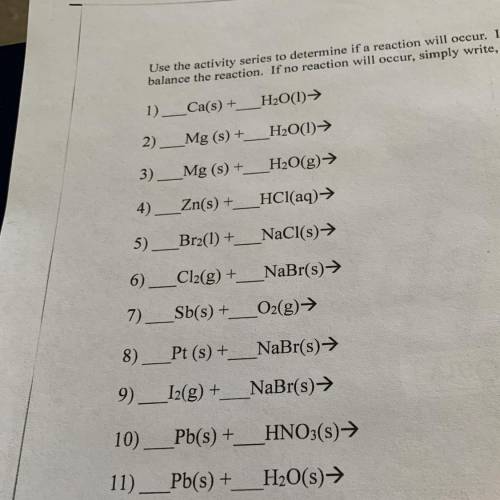
Chemistry, 28.01.2021 20:20 ilovebeans25423
Use the activity series to determine if a reaction will occur I'a reaction will take place, predict the products and balance the reaction. If no ronction will occur, simply write, "no reaction",


Answers: 2


Another question on Chemistry

Chemistry, 22.06.2019 17:00
Reduction is a reaction which results in a in electrons and a in positive charge of the atom or ion 1) a- loss 1) b- gain 2) a-increase 2) b-decrease
Answers: 1

Chemistry, 23.06.2019 05:00
In 1901, thomas edison invented the nickel-iron battery. the following reaction takes place in the battery. fe(s) + 2 nio(oh)(s) + 2 h2o(l) fe(oh)2(s) + 2 ni(oh)2(aq) how many mole of fe(oh)2, is produced when 4.20 mol fe and 6.70 mol nio(oh) react?
Answers: 3

Chemistry, 23.06.2019 18:30
Why must sample spots be above the solvent in paper chromatography
Answers: 1

Chemistry, 23.06.2019 19:00
Question 1 how do an ionic bond and a covalent bond differ? an ionic bond is an attraction between oppositely charged ions. a covalent bond is a sharing of electrons between atoms. a covalent bond is an attraction between oppositely charged ions. an ionic bond is a sharing of electrons between atoms. there is no difference. both an ionic bond and a covalent bond share electrons. there is no difference. both an ionic bond and a covalent bond are attractions between oppositely charged ions. question 2 what is the definition of a covalent bond? a bond between two positive ions a bond between two negative ions a bond between a positive and a negative ion a bond between two atoms question 3 what is a bond called that shares electrons between two neutral atoms? covalent bond ionic bond metallic bond polar bond question 4 water (h2o) is composed of the same elements as carbon monoxide (co). how do their properties compare? they have different properties because the arrangement of atoms is different. they have the same properties because they have the same atoms. they have different properties because they have different atoms. they have the same properties because they have the same arrangement of atoms. question 5 what is the definition of a chemical bond? a mutual attraction between the nuclei and electrons in two different atoms a mutual attraction between the nuclei and electrons in a single atom a mutual repulsion between the nuclei and electrons in two different atoms a mutual repulsion between the nuclei and electrons in a single atom
Answers: 1
You know the right answer?
Use the activity series to determine if a reaction will occur I'a reaction will take place, predict...
Questions

Chemistry, 22.09.2020 20:01

Spanish, 22.09.2020 20:01

Mathematics, 22.09.2020 20:01

English, 22.09.2020 20:01

History, 22.09.2020 20:01



History, 22.09.2020 20:01


Mathematics, 22.09.2020 20:01




Computers and Technology, 22.09.2020 20:01

History, 22.09.2020 20:01





History, 22.09.2020 20:01



